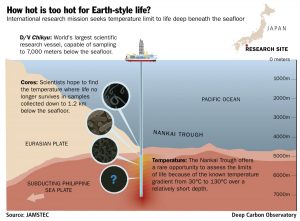
Mission seeks to answer key questions: How deep is Earth’s habitable zone? How deep is the deep subseafloor biosphere? How does the deep biosphere affect life at the surface? Could life have originated deep and moved upward?
Destination:
Nankai Trough, ~120 kilometers off the coast of Japan, where the ocean depth is 4.7 kilometers, and drilling will penetrate a further 1.2 kilometers beneath the seafloor, where layers of sediment and rock reach temperatures of 130°C (266°F), far above water’s boiling point at Earth’s surface.
Mission elements:
- 31 researchers from 8 nations
- World’s largest, most stable scientific research ship
- Helicopters to speed fresh samples from ship to shore
- Super-clean lab on shore to prevent sample contamination
“Over the next 60 days, we have an unprecedented opportunity to learn more about when temperatures become too hot for microbial life to survive below the seafloor,” said Dr. Verena Heuer, expedition co-chief scientist.
The ocean floor is teeming with worms (nematodes) and other eukaryotic organisms, which live in sediments together with a myriad of microbes representing the three domains of life (Archaea, Bacteria, and Eukaryotes). As the sediments get deeper and warmer, microbial forms become less abundant.
During this expedition, scientists will look for as few as 100 cells per cm3, or roughly the equivalent of 100 sand grains floating in an Olympic-sized swimming pool. Finally, in the deepest samples retrieved on this research cruise, the team expects samples beyond the borders of life where current knowledge predicts that no living cells persist. This is the first attempt to explore this boundary, the biotic fringe, in detail. The team aims to determine whether it is sharp, diffuse, or exists at all.
With scientists working simultaneously on land and at sea, the research is part of the International Ocean Discovery Program’s (IODP) Expedition 370: T-Limit of Deep Biosphere off Muroto, and targets many of the science goals of the Deep Carbon Observatory, an international multidisciplinary research program investigating the role of deep carbon in planetary function.
Scientists will share their experiences during the cruise via blogs at https://deepcarbon.net/feature/dco-t-limit-blog and on the Expedition 370 website, http://www.jamstec.go.jp/chikyu/e/exp370/.
Interested individuals can engage with the mission by guessing the temperature limit of life under the seafloor in the Deep Carbon Observatory’s “How hot is too hot?” contest at https://deepcarbon.net/feature/how-hot-is-too-hot.
Limits to life
“We know the microbial biomass living under the seafloor compares to that found in the global ocean,” explained co-chief scientist Dr. Fumio Inagaki. “Yet, there are many unknowns about this mass of life deep below the seafloor, including its diversity, borders, and the factors limiting its survival.”
Previous research at hot vents in the seafloor suggests life can survive temperatures a little above 120°C. DNA molecules, at least under surface conditions, lose their integrity at temperatures between 120-140°C, and without DNA, life as we know it cannot exist. Yet we know that carbon, hydrogen, and other essential building blocks of life are plentiful under even more extreme temperatures deep inside Earth.
“We have the extraordinary opportunity to explore the depth at which sediments and rocks become too hot for life, even for microbes that can live at temperatures greater than 85°C,” said co-chief scientist Heuer. “The gradual increase in temperature from approximately 30°C to 130°C in the sampled sediments will give us the opportunity to explore how microbial life changes with increasing temperatures and ultimately ceases to exist. Is this lower boundary of the subseafloor’s habitable zone like a rigid brick wall or is it like a leaky fence?”
Simultaneous shipboard and land-based science
On 12 September 2016, an international team of 25 researchers will board the drilling vessel (D/V) Chikyu, the world’s largest scientific research vessel, in Shimizu Port in Shizuoka, Japan, to begin a 60-day quest to determine the limits of life below the ocean’s floor. Working with six additional shore-based scientists, the team will attempt to define the temperature limits to deep life in marine sediments and to clarify key factors, including pressure, limiting Earth’s underground habitable zone.
A unique aspect of this endeavor involves investigations occurring simultaneously onboard the Chikyu and on land at the Kochi Core Center. For the first time, helicopters will speed fresh core samples from the Chikyu to the state-of-the-art research facilities in the Kochi Core Center. There, members of the shore-based science team, led by co-chief scientist Dr. Yuki Morono, will analyze samples to determine the geochemical and microbiological characteristics of the sediments, and painstakingly count minuscule and sparse cells.
The team also will use next-generation DNA sequencing technology to determine which organisms can survive in deep subseafloor sediments and their ancestry. Genetic data like these will provide clues showing how resident microbes adapt to such extreme environments.
Explained Morono, “Looking for life in core samples is like looking for a needle in a haystack. At the surface, the sediments are teeming with microbial cells, but in samples from deeper in the core, the cells become far more sparse.”
The state-of-the-art Japanese drilling vessel Chikyu will travel to the central Nankai Trough, ~120 kilometers off the coast of Japan where the ocean is 4.7 kilometers deep, and drill a further 1.2 kilometers beneath the ocean’s floor to collect sediment and rock cores. The total distance from the ocean’s surface to the target sample depth is equivalent to the height of 18 Eiffel Towers. Carefully selected samples from those cores then will be sent on a one-hour helicopter ride for further investigation by the shore-based science team. The team will search for life within the cores at the super-clean laboratory space of the Kochi Core Center, which is run jointly by the Japan Agency for Marine-Earth Science and Technology (JAMSTEC) and Kochi University.
When the 60-day mission ends around 10 November, the shipboard and shore-based investigators will unite at the Kochi Core Center for a day of debriefing. Then the land-based team will spend a further two weeks analyzing samples.
“This expedition is as complex as a mission to outer space might be,” explained Dr. Kai-Uwe Hinrichs, MARUM, University of Bremen, and lead author of the scientific proposal behind the expedition. “It requires the technology to ‘land’ the coring bit on the right spot in over 4 kilometer-deep water, drill through ancient ocean sediments to collect samples far below the ocean floor, bring them back onboard intact, then transport them by helicopter to the super-clean geomicrobiology laboratory to ensure no contamination. Like a space mission, this expedition is fraught with complexity, danger, and vast opportunity for discovery.”
The Nankai Trough off Cape Muroto offers unique conditions where temperatures can approach ~130°C as cores are collected from 1.2 kilometers depth below the seafloor. Based on previous data from deep-sea hydrothermal vents, researchers expect the upper limit of life in the seafloor near 120°C. The hottest life currently catalogued on Earth includes Geogemma barossii, a single-celled organism thriving in hydrothermal vents on the sea floor. Its cells, tiny microscopic spheres, grow and replicate at 121°C. Scientists found the organism, also known as strain 121, in a sample collected during a 2003 expedition to the Juan de Fuca Ridge off the northwest USA coast and named it after Deep Carbon Observatory scientist John Baross (University of Washington, USA), who provided the sample. At pressure characteristic of about 2000-4000 meters deep (20-40 megapascals), scientists reported cell growth and methane production of a competitor for most heat tolerant organism, Methanopyrus kandleri strain 116, up to 122°C.
The Trough is located on the Eurasian plate, where heat flow is particularly high, near its boundary with the subducting young, hot Philippine Sea tectonic plate. At the targeted site, the geothermal gradient is about four times steeper than elsewhere in the Pacific Ocean. Reaching these temperatures in other areas would require collecting cores from ~4 kilometers below the seafloor, rather than 1.2 kilometers as planned.
Researchers found the site in Nankai Trough 15 years ago but now return with a renewed purpose and more advanced technologies, coupled with analysis capabilities of the Kochi Core Center and other top laboratories around the world. Investigators will also consider existing data to learn how cell concentrations drop to zero, or if life continues at a slower pace or with different forms of microbes with different energy needs.
Three co-chief scientists are leading the mission: Drs. Verena Heuer (MARUM, University of Bremen), Fumio Inagaki (Kochi Institute for Core Sample Research/Research and Development Center for Ocean Drilling Science, JAMSTEC), and Yuki Morono (Kochi Institute for Core Sample Research, JAMSTEC). The co-chief scientists, Hinrichs, and many others on the science team are members of the Deep Carbon Observatory.
IODP Expedition 370 will address some of the Deep Carbon Observatory’s fundamental objectives regarding deep life, which include mapping the abundance and diversity of subsurface marine microorganisms in time and space as a function of their genomic and biogeochemical properties, and their interactions with deep carbon.
Note: The above post is reprinted from materials provided by Deep Carbon Observatory.









